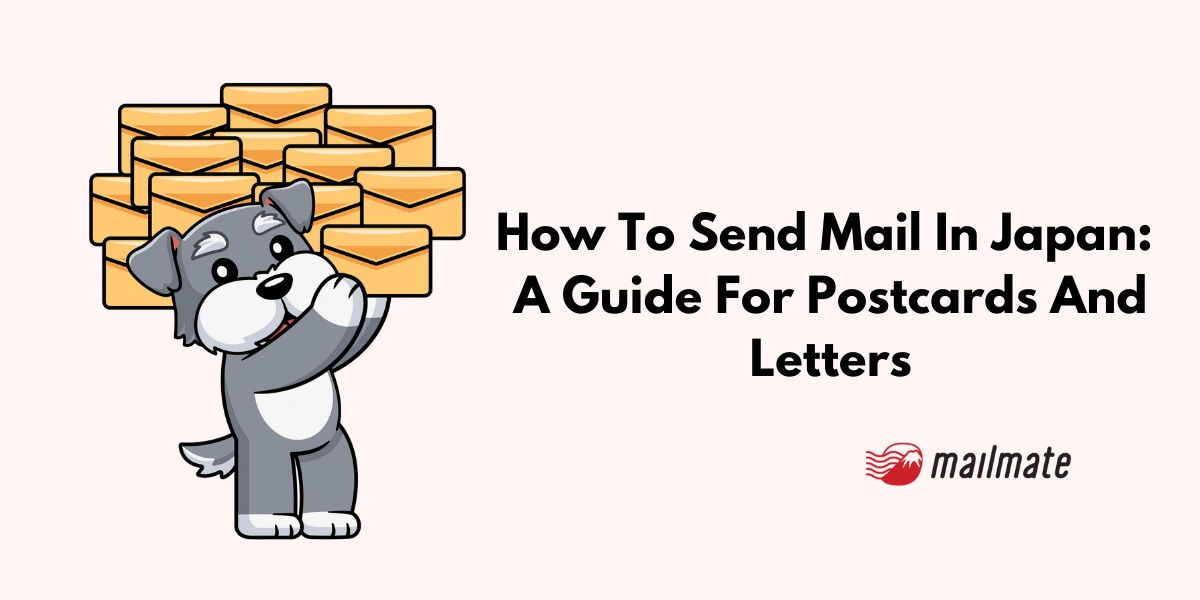How To Send Mail In Japan: A Guide For Postcards And Letters

Learning how to send mail in Japan, or even a postcard, is easy when you have all the tools.
So here are the best tips to know when you want to send mail in Japan.
Tip #1: Get the right size envelope.
For the most part, Japan Post will accept envelopes of all sizes.
The two most common envelopes are Japanese-style (vertical) and Western-style (horizontal) envelopes.
We focus on letters and postcard sizes, but Japan Post can handle various sizes and packages.
Letter size

Japan Post
Letters can be sorted into two categories: standard and non-standard size.
A standard-sized letter is, at minimum, 14 cm by 9cm and, at maximum, 23.5 cm by 12cm with a thickness of 1cm.
A nonstandard-sized letter can be divided into smaller subcategories:
Within 1kg, the maximum dominion is 34 cm in length, 25 cm in width, and 3 cm in thickness.
Over 1kg but under 4kg: The combined dimensions of length, width, and height (A + B + C) should not exceed 90cm, with the longest dimension being 60cm.
Postcard size

Japan Post
There are two common postcards that people send:
Regular postcards: a minimum size of 14 cm by 9cm and a maximum dimension of 15.4cm by 10.7cm with a limited weight between 2g and 6g.
Return postcards: a minimum height of 15 cm with a total length of 9cm, while the maximum dimension of height is 15.4 cm and a length total of 10.7cm.
Tip #2: Know how to write your address.
There are many different ways to write a Japanese address, depending on who and where, as well as the type of envelope it is written on.
Vertical address writing
It mostly applies to Japanese-style vertical envelopes where you must write the address vertically due to its size.

Image: Midori Japan
From right to left, here is how you should write a Japanese address vertically:
Zip code: Write the postal code (郵便番号) in the small red squares at the top right of the envelope.
Right-most side: Write prefecture, city or ward, and the town or district
Next column: Write the building's name and the room number.
Write the recipient's name next to the previous column.
Write the sender's address on the front of the envelope if there's room. If not, you can write the return address on the back.
Horizontal address writing
When you have Western-style envelopes, you'll need to write the address horizontally.
The recipient's address should be at the top left corner and be written as:
First line: Write the postal code.
Second line: Write the prefecture, city, ward, town, and district.
Third line: Write the building's name and room number.
Fourth line: The recipient's name.
The format above is the Japanese address format. Continue to read on how to write a Japanese address in English.
English vs. Japanese address
Writing in Japanese can be intimidating, especially when you need to write complicated kanji in a small format, which is why Japan Postal Services accepts addresses in English.

Different in Japanese address vs international postal address
However, it must be written in an international postal format, so the address must start with the recipient's name and end with the postal code.
Print vs. handwritten address
In Japan, handwritten addresses are commonly accepted for domestic mail. So, you can send letters, postcards, and packages using a handwritten address or label as long as it is clear and legible.
However, printed addresses are also accepted by Japan Post. Ensure the label or paper is securely attached to the envelope to avoid mishandling.
However, you'll need to print an international parcel label for international postage, such as Express Mail Service (EMS) or registered mail. Japan Post requires electronic advance data for international shipments, so you need a printed label.
Tip 3: Buying postage
Japan offers amazing regular, seasonal, and special stamps that you can buy.
At a local Japanese post office
The most common way to buy stamps is at the post office. Larger Japanese post offices will display all the available stamps you can purchase.

You can write down which stamp you want to buy or take the small pieces of paper with you. When your number is called, bring your items and tell them how many stamps you want.
At the convenience store
Japanese convenience stores can also sell stamps. But before being careful, you need to see if they have a Japan Post symbol (〒) on the front, as not all conbini in Japan sell them.
You’ll find that Japanese convenience stores tend to sell standard postage stamps.
Japan Post online shop
Japan Post’s online shop allows you to browse all available stamps you can purchase.

Japan Post specialty stamps
You can shop for specialty stamps (特殊切手) with amazing seasonal desand regular postage stamps (普通切手) here.
Be aware that there is a shipping fee of 300 something yen. So, if you buy online, it’s better to buy in bulk.
Tip 4: Postage rates
When sending any mail item, it’s important to know how much the postage is so it can be properly sent.
When you have the appropriate stamps on your letter or postcard, you can place it in your nearest postbox.
Letters
This section only includes standard-sized and non-standard-sized mail.
Check Japan Post’s other mail category and their respective postage rates.
Domestic letter mail
Check Japan Post’s domestic letter postage for more than 100g.
Standard-sized mail
100 yen for up to 50 g
Non-standard mail
140 yen for up to 50 g
180 yen for up to 100 g
International letter mail
When sending international mail, shipping it through AirMail is the fastest way to send postal letters.
You can choose surface mail. However, your mail item can take 1-3 months to arrive.
Zone 1: Korea, Taiwan, China
-
Standard-sized mail:
120 yen for up to 25 g
190 yen for up to 50 g
-
Non-standard mail:
230 yen for up to 50 g
340 yen for up to 100 g
Zone 2: Asia (excluding China, South Korea, Taiwan)
-
Standard-sized mail:
120 yen for up to 25 g
190 yen for up to 50 g
-
Non-standard mail:
230 yen for up to 50 g
350 yen for up to 100 g
Zone 3: Oceania, North America (excluding the U.S.), Middle East, Europe
-
Standard-sized mail:
140 yen for up to 25 g
220 yen for up to 50 g
-
Non-standard mail:
280 yen for up to 50 g
420 yen for up to 100 g
Zone 4: U.S. (including Guam and other U.S. territories)
-
Standard-sized mail:
140 yen for up to 25 g
220 yen for up to 50 g
-
Non-standard mail:
280 yen for up to 50 g
420 yen for up to 100 g
Zone 5: Central and South America (excluding Mexico), Africa
-
Standard-sized mail:
160 yen for up to 25 g
260 yen for up to 50 g
-
Non-standard mail:
320 yen for up to 50 g
500 yen for up to 100 g
Postcards
The postcard postage rate is 85 yen per postcard throughout Japan. For a round-trip postcard, it’ll be 170 yen.
International postcards by airmail is a flat rate of 100 yen everywhere.
Greeting cards
Domestically, greeting cards can be categorized as non-standard mail. So follow Japan Post’s non-standard mail postage rates.
For greeting cards that are being sent internationally, it’ll be:
First Zone (Korea, Taiwan, China): 120 yen
Second Zone Asia (excluding China, South Korea, and Taiwan: 120 yen
Third Zone: Oceania, North America (excluding the U.S.), Middle East, Europe: 140 yen
Fourth Zone U.S. (including Guam and other U.S. territories): 140 yen
Fifth Zone Central and South America (excluding Mexico), Africa: 160 yen
Let Japan Post handle it
If these postage rates are a little confusing, you can bring your mail items to the nearest Japan Post office!
The staff will handle the category and calculate the postage. All you have to do is pay the amount.
You can also ask about their additional services, such as express delivery or selecting a preferred delivery date to ensure your mail arrives exactly when needed. However, it only applies to domestic mail.
In closing
Whether you are sending a letter or a postcard, you know how to send mail in Japan. If you are ever confused or unsure about the correct postage, visit your local post office, as the staff can help you from there.
Spending too long figuring out your Japanese mail?
Virtual mail + translation services start at 3800 per month. 30-day money-back guarantee.

